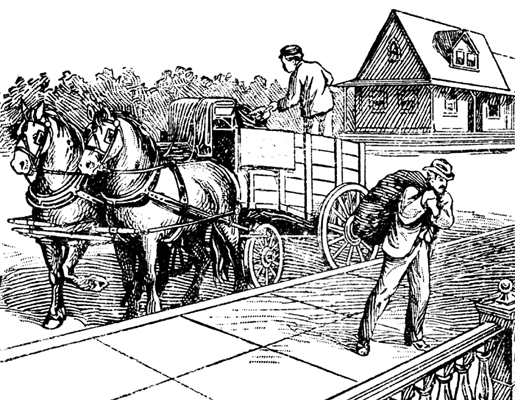horse & buggy – digital museum.

(image credit: William J. Milne Progressive Arithmetic (New York: American Book Company, 1912)43)
In 1885, Philadelphia lawyer, Thomas Donaldson, planned to buy Walt Whitman a horse and buggy. This expensive gift required donations from Whitman’s extensive social network, including Mark Twain and Oliver Wendell Holmes. According to David S. Reynolds, on September 17, 1885, a new horse and buggy awaited Whitman on Mickle Street, clearly visible from Whitman’s bedroom window. The gift was a pleasant surprise for the poet. Despite his elderly age, Whitman was immediately taken with this new-fangled form of transportation and he enjoyed the horse’s ability race down the streets, rapidly moving by shops and row homes. Reynolds’s cultural biography makes the claim that while he rode in the buggy, Whitman “displayed agility and sometimes reckless speed, in guiding his horse, Frank, through the Camden streets” (553) and Reynolds describes Whitman’s driver, William Duckett, as a “rougish teenager” (553). But Frank wasn’t even quick enough to suit Whitman’s desire to wildly race through Camden. Reynold’s states that after five months “Whitman sold his horse, Frank, [and] got a faster one, Nettie, but he had to give up the carriage after his strokes in June 1888″ (553). Even though Whitman only owned a horse and buggy for roughly three years, it was America’s most popular form of transportation the later half of the nineteenth century.

(image credit: Foster, Ellsworth D. The American Educator (Chicago: Ralph Durham Company, 1921) 592)
What exactly was the purpose and structure of the buggy? According to the OED, the buggy itself is “a light one-horse (sometimes two horse) vehicle, for one or two persons. Those in use in America have four wheels” (OED 1a), differing from the two wheeled carriages common in England. These wagons were designed to have strong pulling efficiency even when the horses were given a heavy load, and people enjoyed riding in the buggies to reach their destination in a timely manner. Whitman’s own horse and buggy cost a sum of $320, indicating this transportation was reserved for people who had an adequate amount of money. Reynolds illustrates Whitman’s gift for the reader, saying it included “a horse, a leather-lined phaeton, a whip, halter, and lap blanket” (553). The last item useful for the colder winter months, making a horse ride a pleasant experience for all times of the year, not limiting the horse’s usefulness for the warm summer months.
Clay McShane’s article, “Gelded Age Boston,” discusses the growth and usefulness of horses and buggies in 1880’s Boston, a city not too far north from Camden. The historical article discusses how, depending on the individual owners’ wishes and purposes, different horse breeds were suited for different businesses. For example, “breweries preferred Clydesdales, unsuited to the North American climate but handsome high-steppers that provided good publicity for the industries they represented” (291) and carriage owners, like Whitman, “preferred light, young, agile animals” (291).
Regardless of the benefits, owners of horses and buggies faced several challenges, especially people like Whitman, who lived in an urban neighborhood. The urban surroundings were laden with diseases that could easily spread to the animals, rendering them useless. McShane’s research shows that although “farriers (horseshoers) served as folk practitioners of veterinary medicine . . . their nostrums would not do in an age that increasingly valued professionalization” (287). In order to combat this issue, veterinary medicine developed into a new profession to care for the equine population and “Harvard opened [the first] veterinary school in 1882, which was active until 1904, roughly when urban horses began to lose their importance” (287). The school’s curriculum focused entirely on the well-being of draft animals.
Animal abuse was also a major concern in cities and in 1868, George Angell attempted to quell the problem by founding the MSPCA or Massachusetts Society for the Prevention of Cruelty to Animals. The MSPCA revealed “astonishing examples of cruelty, including the practice of lighting fire under a horse to urge him to start pulling a heavy load,” and the MSPCA publicly denounced these incidents to raise awareness among potential horse and buggy owners.
By the 1910’s, the development and eventual market for automobiles diminished the use for the horse and buggy. McShane’s conclusion states “they had all but faded from view” (300), being a image of America’s past and Whitman’s later life.

(image credit: Charles D. Maginnis Pen Drawings an Illustrated Treatise (Boston: Bates & Guild Company, 1903) 57)
Works Cited
McShane, Clay. “Gelded Age Boston.” The New England Quarterly, Inc. 74.2 (June 2001): 274-302.
Reynolds, David S. Walt Whitman’s America: A Cultural Biography. New York: Vintage Books, 1995.